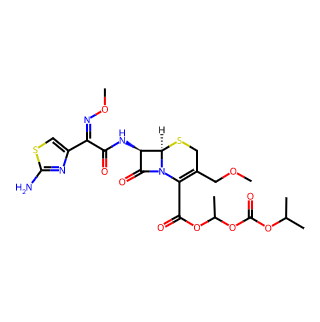- Synthetic anti-infective drugs
- Medications for the digestive system
- Antipyretic and analgesic drugs
- Medications for the blood system
- Medications for the respiratory system
- Anti-allergic drugs
- Medications for the urinary system
- Diagnostic medications
- Immunosuppressive and immunomodulatory drugs
- Vitamins and mineral supplements
- Antioxidants and medications for osteoporosis
- Antiparasitic drugs
- Ophthalmic medications
- Amino acids and their derivatives
- Dermatological medications
- Medications for the circulatory system
- Antitumor drugs
- Medications for the nervous system
- Hormonal and endocrine function-regulating drugs
- Antibiotics
- Others
CAS Number: 87239-81-4




I. Basic Information
Product Number: Cefpodoxime proxetil
Molecular Formula: C21H27N5O9S2Cefpodoxime proxetil
Molecular Weight: 557.6 (or 557.597)
CAS Number: 87239-81-4
Melting Point: 111°C to 113°C
Density: 1.6±0.1 g/cm3
PSA: 234.51000
LogP: 2.17
II. Pharmacological Action
Antibacterial Spectrum: Cefpodoxime proxetil, after being hydrolyzed by nonspecific esterases in vivo to cefpodoxime, exerts antibacterial activity against both Gram-positive and Gram-negative bacteria.
Mechanism of Action: Cefpodoxime proxetil inhibits the biosynthesis of microbial cell walls, leading to bactericidal activity. Specifically, it binds to four sites on specific penicillin-binding proteins, inhibiting bacterial cell wall peptidoglycan synthetase (including transpeptidase, carboxypeptidase, and endopeptidase), thereby impeding the synthesis of cell wall peptidoglycan, causing cell wall defects, bacterial swelling, deformation, and lysis.
β-Lactamase Stability: Cefpodoxime proxetil is stable to β-lactamases, so many β-lactamase-producing microorganisms resistant to penicillin and cephalosporins remain sensitive to this product, but it is ineffective against some extended-spectrum β-lactamases.
III. Drug Interactions
When combined with antacids (such as aluminum hydroxide) or H2 receptor antagonists (such as ranitidine), Cefpodoxime proxetil's plasma concentration and drug absorption may be reduced due to neutralization of gastric acid.
Coadministration with drugs that increase gastric pH can result in significant decreases in Cmax and AUC values, while coadministration with drugs that decrease gastric pH can increase cefpodoxime absorption.
Acetylcysteine can disrupt the β-lactam ring, affecting cephalosporin absorption and reducing cephalosporin bioavailability, but it has no significant effect on the bioavailability of Cefpodoxime proxetil.

Tai Yau Street, San Po Kong, Kowloon, Hong Kong, China.



